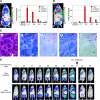A BAC transgenic reporter recapitulates in vivo regulation of human telomerase reverse transcriptase in development and tumorigenesis
- PMID: 21135040
- PMCID: PMC3042838
- DOI: 10.1096/fj.10-173989
A BAC transgenic reporter recapitulates in vivo regulation of human telomerase reverse transcriptase in development and tumorigenesis
Abstract
Telomerase is tightly regulated in humans relative to mice, owing to the differential regulation of TERT genes. To explore hTERT regulation in vivo, we engineered mice with a 160-kb transgenic bacterial artificial chromosome (BAC) spanning the hTERT locus with a Renilla luciferase (Rluc) cassette downstream of its promoter. Analysis of multiple founder lines revealed that the Rluc expression profile from the transgenic hTERT reporter locus reproduced that of the native hTERT gene in all tissues and organs examined, demonstrating that genetic sequence determined the species-specific developmental regulation of the hTERT gene and that mouse epigenetic and transcription machineries faithfully regulated hTERT transcription. Thus, these mice allowed detailed analyses of developmental hTERT regulation. Both the transgenic hTERT reporter and the endogenous mTERT locus were expressed in early embryonic stages, and their mRNA levels progressively decreased throughout embryonic and postnatal development. Whereas hTERT transcription was much lower than mTERT expression in most organs, it increased significantly during postnatal development of thymus, testis, and ovary. In testis, the Rluc mRNA was enriched in elongating spermatids of seminiferous tubules. In addition, the transcription of transgenic hTERT reporter, but surprisingly not the endogenous mTERT gene, was activated during Wnt1-induced mammary tumorigenesis, allowing the monitoring of tumor development via noninvasive bioluminescent imaging. Collectively, our results demonstrate that the hTERT transgenic reporter system recapitulates the developmental regulation of the hTERT gene in a chromosomal position-independent manner and serves as a legitimate model to explore telomerase regulation in the development of normal and neoplastic tissues in vivo.
Figures





References
-
- Morin G. B. (1989) The human telomere terminal transferase enzyme is a ribonucleoprotein that synthesizes TTAGGG repeats. Cell 59, 521–529 - PubMed
-
- Lingner J., Hughes T. R., Shevchenko A., Mann M., Lundblad V., Cech T. R. (1997) Reverse transcriptase motifs in the catalytic subunit of telomerase. Science 276, 561–567 - PubMed
-
- Meyerson M., Counter C. M., Eaton E. N., Ellisen L. W., Steiner P., Caddle S. D., Ziaugra L., Beijersbergen R. L., Davidoff M. J., Liu Q., Bacchetti S., Haber D. A., Weinberg R. A. (1997) hEST2, the putative human telomerase catalytic subunit gene, is up-regulated in tumor cells and during immortalization. Cell 90, 785–795 - PubMed
-
- Harrington L., McPhail T., Mar V., Zhou W., Oulton R., Bass M. B., Arruda I., Robinson M. O. (1997) A mammalian telomerase-associated protein. Science 275, 973–977 - PubMed
-
- Shippen-Lentz D., Blackburn E. H. (1990) Functional evidence for an RNA template in telomerase. Science 247, 546–552 - PubMed
Publication types
MeSH terms
Substances
Grants and funding
LinkOut - more resources
Full Text Sources
Molecular Biology Databases
Research Materials

